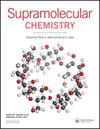Calixarene: a versatile scaffold for the development of highly sensitive biosensors
IF 2.6
4区 化学
Q3 CHEMISTRY, MULTIDISCIPLINARY
引用次数: 6
Abstract
ABSTRACT Calix[n]arenes, as the ‘third-generation’ host molecules, are cyclic oligomer, featuring a unique three-dimensional structure with a hydrophobic cavity, allowing the interaction with many size-matched guest molecules, and a surface which can be functionalised at both the upper and lower rims with several functional groups to tailor the recognition properties towards a specific class of analytes for various applications. In the last two decades, due to their configuration, unique molecule recognition function and aggregation properties, calixarenes and their derivatives have attracted considerable attention as a new versatile scaffold for highly sensitive detection and site-oriented immobilisation in biosensor development. In this review, the development of sensors featuring calixarene-based transducers tuned for binding many analytes, ranging from simple (i.e., amino acids and neurotransmitters) to complex (i.e., enzymes and antibodies) organic molecules, was described. The rational design, the synthetic strategies fine-tuned to prepare these complex structures and their grafting in surface modification were included. GRAPHICAL ABSTRACT杯芳烃:用于开发高灵敏度生物传感器的多功能支架
杯[n]芳烃作为“第三代”宿主分子,是一种环状低聚物,具有独特的三维结构和疏水腔,允许与许多尺寸匹配的客体分子相互作用,并且表面可以在上边缘和下边缘与几个官能团进行功能化,以适应各种应用中对特定类别分析物的识别特性。在过去的二十年中,杯芳烃及其衍生物由于其独特的结构、独特的分子识别功能和聚集特性,作为一种新型的多功能支架,在生物传感器的开发中用于高灵敏度检测和定位固定化,受到了广泛的关注。在这篇综述中,介绍了以杯芳烃为基础的传感器的发展,这些传感器可以结合许多分析物,从简单的(即氨基酸和神经递质)到复杂的(即酶和抗体)有机分子。介绍了制备这些复杂结构的合理设计、精细的合成策略及其在表面改性中的接枝。图形抽象
本文章由计算机程序翻译,如有差异,请以英文原文为准。
求助全文
约1分钟内获得全文
求助全文
来源期刊

Supramolecular Chemistry
化学-化学综合
CiteScore
3.60
自引率
3.00%
发文量
5
审稿时长
2.7 months
期刊介绍:
Supramolecular Chemistry welcomes manuscripts from the fields and sub-disciplines related to supramolecular chemistry and non-covalent interactions. From host-guest chemistry, self-assembly and systems chemistry, through materials chemistry and biochemical systems, we interpret supramolecular chemistry in the broadest possible sense. Interdisciplinary manuscripts are particularly encouraged. Manuscript types include: high priority communications; full papers; reviews, and; Methods papers, techniques tutorials highlighting procedures and technologies that are important to the field. We aim to publish papers in a timely fashion and as soon as a paper has been accepted and typeset it will be published in electronic form on the Latest articles section of the website. The two most important review criteria are that the paper presents high-quality work that fits generally into the broad spectrum of activities in the supramolecular chemistry field. Under normal circumstances, Supramolecular Chemistry does not consider manuscripts that would be more suitable in a highly specialized journal. This includes, but is not limited to, those based mostly or exclusively on topics such as solid state/X-ray structures, computational chemistry, or electrochemistry. .
The two most important review criteria are that the paper presents high-quality work that fits generally into the broad spectrum of activities in the supramolecular chemistry field.
 求助内容:
求助内容: 应助结果提醒方式:
应助结果提醒方式:


